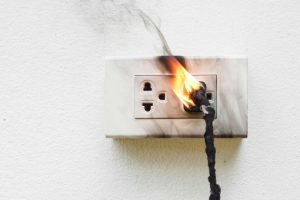 Cloth-covered wiring is a common subject that many homeowners end up faced with. It is often synonymous with old homes and you may not even know you have them. Read on for all you need to know about cloth-covered wiring in this article.
Cloth-covered wiring is a common subject that many homeowners end up faced with. It is often synonymous with old homes and you may not even know you have them. Read on for all you need to know about cloth-covered wiring in this article.
Understanding Cloth Covered Wiring
The simple description for cloth-covered wiring is electric wiring insulated or covered with cloth/fabric material. If it sounds old school, know that it is indeed old school and was the norm between the 1950s and 1970s. It seemed like a good idea at the time, especially since it was affordable and there were no better options.
After the decades of using cloth insulation for electric wiring, plastic insulation was discovered and refined and became the standard for all wiring needs. Cloth-covered wiring is now considered as an electrical hazard because of their many shortcomings.
Why cloth-covered wiring became bad news?
Using cloth as an insulator quickly proved dangerous because cloth material can deteriorate over time. The more brittleness and deterioration occurs, the higher the risk of an electric fire from the heat produce by wires.
Cloth is also an easy target for rodents and insects that can chew on it and expose the wires underneath.
In addition to these drawbacks, some cloth-covered wiring is further insulated with asbestos. Asbestos is known as a dangerous carcinogen to humans. Hence, like the cloth covering wears away over time, the asbestos breaks down and becomes airborne. This puts human lives at risk.
There is also the common issue of cloth wiring not being properly grounded. This presents even more danger to lives and property.
Recognizing Cloth Covered Wiring
- Check for knob-and-tube wiring. Knob-and-tube wiring was also widely used at the same time as cloth covered wiring. It comprises ceramic knobs and tubes used for running wires through the walls. This wiring is also considered outdated and unsafe. If you have knob-and-tube wiring, then you likely have cloth wiring because cloth was often used for insulating knob-and-tube wiring with a rubber outer covering.
- Check for the manufacturer. You can find the manufacturers or brand names of cloth wiring companies on the cloth-covered wiring. Many of these companies are no longer in business or have been sold off to other companies. Some names to look out for include:
- Narax
- Ammcoflex
- Cirtrex
- Dutrax
- Cres-Flex
- Hatflex
- Essex
- Triangle PWC
- Southwire
- Call an electrician. If you are still in doubt or unable to recognize the wiring on your own, it’s best to call a professional electrician or home inspector. These experts will recognize cloth-covered wiring easily and will tell you if you need a house rewire.
Removing Cloth Covered Wiring
It’s good to know that not all cloth covered wiring spell danger for your home or building. The best way to know if you need to remove your cloth-covered wiring is to call an electrician. In cases where you need to remove and replace the outdated cloth-covered wiring in your home or building, this can only be completed by a licensed electrician.




